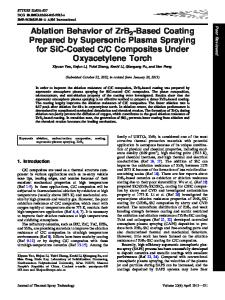Wear Resistance under Different Temperatures of NiCr-Cr 3 C 2 Coating Remelted by Tungsten Inert Gas Arc
- PDF / 8,622,255 Bytes
- 12 Pages / 593.972 x 792 pts Page_size
- 14 Downloads / 281 Views
JMEPEG https://doi.org/10.1007/s11665-020-05254-2
Wear Resistance under Different Temperatures of NiCr-Cr3C2 Coating Remelted by Tungsten Inert Gas Arc Li Guo-lu, Yuan Jing-min, Dong Tian-shun, Zhao Xiang-wei, Fu Bin-guo, and Shi Jiadong Submitted: 20 July 2020 / Revised: 24 September 2020 / Accepted: 18 October 2020 In this work, a NiCr-Cr3C2 coating was prepared on the AISI 1045 steel substrate by plasma spraying, then subjected to tungsten inert gas arc (TIG) remelting treatment. The microstructure, hardness and the wear test under different temperatures (25, 200, 400, and 600 °C) of the NiCr-Cr3C2 coatings before and after remelting were studied comparatively. The results show that after TIG remelting, the internal structure of the coating was dense, and the defects were greatly reduced. The hardness of the remelted coating surface became uniform and increased from 1007 HV0.1 to 1141 HV0.1, with an increase of 13.3%. At different temperatures, the weight loss of the remelted coating was always less than that of the sprayed coating, with a significant reduction of about 75%. The friction coefficients of the remelted coating and sprayed coating at 25 and 200 °C were basically the same, while the friction coefficients of the remelted coating at 400 and 600 °C were smaller than that of the sprayed coating. The wear mechanism of the remelted coating under different temperature were abrasive wear and adhesive wear, while that of the sprayed coating were fatigue wear, abrasive wear, and adhesive wear. Therefore, the TIG remelting treatment can optimize the microstructure of the NiCr-Cr3C2 coating and remarkably improve the wear resistance. Keywords
high-temperature wear resistance, NiCr-Cr3C2 coating, plasma spraying, TIG remelting
1. Introduction Chromium carbide is a commonly used thermal spraying material in engineering. There are three common Cr-C compounds, namely, Cr3C2, Cr7C3, and Cr23C6, whose hardness are quite high even at high temperatures (Ref 1-3). NiCr is a kind of commonly used alloy with excellent heat resistance and corrosion resistance (Ref 4). Thus, the coating prepared by NiCr-Cr3C2 has wonderful oxidation resistance and abrasion resistance even under severe conditions such as high temperature and heavy load. Its typical applications are boiler tube, metallurgical furnace roll, engine cylinder, etc., (Ref 5, 6). A common process for preparing NiCr-Cr3C2 coating is plasma spraying (Ref 7). However, the coating prepared by this method is mechanically bonded to the substrate, and has many defects such as cracks, inclusions, and pores. This makes the coating easy to fail in practical applications, leading to the excellent properties of NiCr-Cr3C2 cannot be fully utilized (Ref 8, 9). Studies have shown that remelting the sprayed coating can optimize the microstructure and improve properties of the coating, and further extend the service life of the components (Ref 10-12). Tungsten inert gas arc (TIG) remelting has high processing temperature, concentrated energy, and its equipment cost is low which is b
Data Loading...











